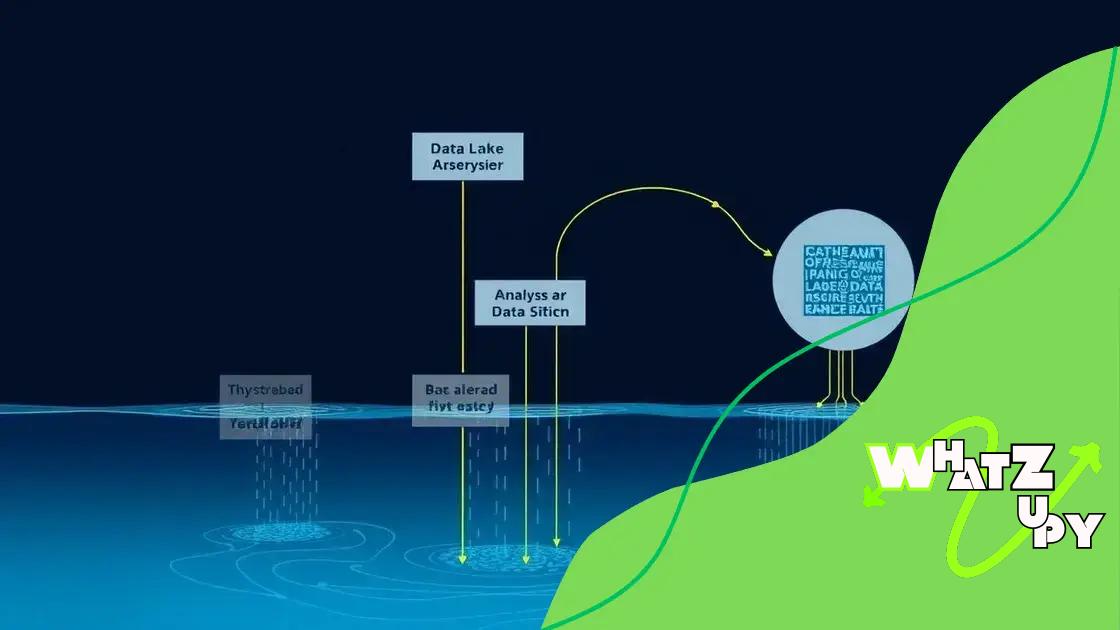Leveraging data lakes for business intelligence

Leveraging data lakes for business intelligence allows organizations to store, analyze, and gain insights from vast amounts of structured and unstructured data, driving improved decision-making and operational efficiency.
Leveraging data lakes for business intelligence can transform the way your business utilizes data. Have you ever wondered what it feels like to extract valuable insights from a vast pool of information? Let’s dive into this exciting topic!
Understanding data lakes and their role
Understanding data lakes is vital for businesses seeking to harness the power of their data more effectively. Essentially, a data lake is a centralized repository that allows you to store all your structured and unstructured data at any scale.
This flexibility enables companies to manage vast amounts of data without needing to preprocess it. By understanding how data lakes work, organizations can gain valuable insights and improve decision-making.
Key Features of Data Lakes
Data lakes possess several features that set them apart from traditional data storage solutions:
- Scalability: Data lakes can store an almost unlimited amount of data, making them ideal for businesses generating large quantities of information.
- Cost-effectiveness: Storing data in a data lake is often cheaper than in a traditional database because you benefit from lower storage costs.
- Flexibility: You can easily add new data sources without significant changes, reducing the need for extensive IT intervention.
Another important aspect of data lakes is their ability to support various data types. Whether your data is documents, images, audio, or videos, a data lake can store it all in its native format. This eliminates the need for complicated schemas and allows for a more agile approach to data analysis.
As organizations begin to leverage data lakes, they gain unique opportunities to analyze trends. For example, with machine learning, businesses can automate insights generation from data lakes, enabling even more strategic planning.
Data Governance and Security
Even though data lakes provide many advantages, they also come with challenges. Data governance is crucial, as the volume and variety of data can lead to management difficulties. Establishing clear data governance policies ensures that data remains accessible, secure, and compliant with regulations.
Security protocols must be upheld to protect sensitive information stored in data lakes. Applying encryption methods and access controls can safeguard data against breaches.
By grasping the fundamentals of data lakes and their role, organizations can unlock the full potential of their data resources. This knowledge paves the way for improved analytics, enhanced decision-making, and overall business growth.
Key benefits of data lakes for businesses
Data lakes offer numerous benefits that can significantly enhance business operations. These advantages primarily stem from their ability to store vast amounts of data in its raw form. With a data lake, businesses can achieve more comprehensive insights, promote better decision-making, and foster innovation.
Improved Data Accessibility
One key benefit of data lakes is their improved accessibility. By centralizing data from various sources, employees can access all relevant information quickly. This streamlined access allows teams to respond faster to market changes and consumer needs.
- Faster analysis: Data lakes enable quicker reporting and analytics, allowing for timely insights.
- Collaboration: Teams can collaborate more effectively, as everyone has access to the same set of data.
- Self-service tools: Users can employ self-service analytics to generate insights without needing extensive IT support.
Furthermore, a data lake allows for the storage of structured, semi-structured, and unstructured data. This flexibility means businesses can gather insights from a wider range of information, such as social media posts, customer feedback, and sensor data. By analyzing diverse data types together, companies can identify patterns and trends that may not be visible from traditional data sources.
Cost Efficiency
Another significant advantage of data lakes is their cost efficiency. Storing data in a data lake typically costs less than in traditional databases since organizations can leverage lower-cost storage options. This cost-effective solution allows businesses to hold onto large quantities of data without breaking the bank.
Additionally, the ability to store raw data means organizations won’t need to spend excessive resources on data preparation and transformation, which can be costly and time-consuming. Instead, they can focus on analytics and derive value from the data.
In summary, the key benefits of data lakes for businesses include improved accessibility, cost efficiency, and the capability to analyze diverse data types. As organizations increasingly recognize these advantages, they are more likely to leverage data lakes as part of their data strategy.
How to build a successful data lake

Building a successful data lake requires careful planning and execution. The process involves several key steps that organizations must consider to ensure they utilize their data effectively.
Define Your Goals
The first step in building a data lake is to clearly define your goals. What problems are you trying to solve? Identifying specific objectives helps guide the overall design of your data lake.
- Improving analytics: Are you looking to enhance your analytics capabilities?
- Data consolidation: Do you want to unite all your data into one place?
- Fostering innovation: Are you aiming to support new business models or innovations?
Once you have established your goals, it becomes easier to determine the types of data you need to collect and analyze.
Select the Right Technology
Choosing the right technology stack is crucial for a successful data lake. There are various platforms and tools available that cater to different needs. Many organizations opt for cloud-based solutions due to their scalability and cost-effectiveness.
Look for technologies that offer:
- Scalability: As your data grows, the technology should easily adapt to handle increased storage and processing.
- Integration capabilities: The ability to integrate with existing systems ensures a smooth data flow.
- Data governance features: Tools that provide metadata management and security options help maintain data quality and compliance.
Once you have your technology stack in place, begin the process of data ingestion. This step involves collecting and storing data from various sources into your data lake.
Furthermore, it is essential to implement strong data governance practices. This ensures that your data lake remains organized, secure, and compliant with regulations. Establish clear protocols for data access, quality control, and usage to avoid any complications down the line.
Continuously Monitor and Evolve
Lastly, building a successful data lake is not a one-time effort. It requires continuous monitoring and evolution. Analyze the performance of your data lake regularly and seek areas for improvement.
Adapt to changes in technology and business needs to ensure that your data lake remains an asset. Keep learning from the insights gathered and refine your approach accordingly.
Best practices for managing your data lake
Managing a data lake effectively is essential for maximizing its value. Following best practices can help ensure that your data lake remains organized, accessible, and secure.
Implement Data Governance
Data governance is crucial for any data lake. Establishing clear policies and procedures helps maintain data quality and ensures compliance with regulations. Without proper governance, a data lake can become disorganized and difficult to navigate.
- Define roles: Assign responsibilities for managing and securing the data.
- Set policies: Create guidelines for data access, usage, and sharing.
- Regular audits: Conduct audits regularly to ensure compliance with your governance policies.
By implementing these practices, organizations can safeguard their data and maintain its integrity over time.
Ensure Scalability
Another best practice is to design your data lake for scalability from the start. This involves selecting the right technology that allows for easy expansion as your data needs grow. A scalable data lake can handle increased volumes without affecting performance.
Consider the following factors:
- Cloud solutions: Utilize cloud storage options that automatically scale as you add more data.
- Flexible architecture: Build your data lake with a modular design that can easily incorporate new data sources.
- Performance monitoring: Regularly assess performance to ensure that the data lake can handle growth.
Additionally, establishing a strong metadata management strategy is vital. Proper metadata lets users understand the data they have, improving data discovery and usability.
Provide Training and Support
A well-managed data lake is only effective if users know how to leverage it. Offering regular training and support is essential for empowering teams to extract insights effectively. Consider:
- Workshops: Host workshops to help staff understand the data lake’s capabilities.
- Documentation: Create clear documentation that guides users through processes.
- Encourage feedback: Foster an environment where users can share their experiences and suggestions.
Encouraging a culture of data usage and giving users the tools to access and analyze the data will greatly enhance results.
Real-world examples of data lakes in action
Real-world examples of data lakes in action illustrate how they can transform businesses. Many companies are leveraging data lakes to optimize their operations, enhance customer experiences, and drive innovation.
Retail Success Story
A well-known retail giant implemented a data lake to consolidate data from various sources, including point of sale systems and social media. This allowed them to gain a 360-degree view of customer behaviors.
Key outcomes included:
- Personalized marketing: Enhanced targeting of promotions based on customer preferences.
- Inventory management: More accurate forecasting of product demand, reducing excess stock.
- Improved customer satisfaction: Faster response times to customer inquiries and complaints.
By analyzing customer data more effectively, the retailer was able to increase sales and loyalty.
Healthcare Innovations
The healthcare sector is also tapping into the potential of data lakes. A leading healthcare provider built a data lake to bring together patient records, clinical data, and wearable device data.
Some benefits they achieved were:
- Improved patient outcomes: Data-driven insights led to personalized treatment plans.
- Enhanced research capabilities: Researchers could easily access a vast amount of data for clinical trials.
- Operational efficiencies: Streamlined operations through better allocation of resources based on data analysis.
This integration of data not only improved patient care but also reduced costs significantly.
Financial Sector Usage
In the finance industry, many firms are implementing data lakes for fraud detection and risk assessment. A prominent bank adopted a data lake to analyze transactions in real-time.
The bank experienced:
- Faster fraud detection: Immediate alerts for suspicious activities.
- Improved risk management: Data analytics helped assess risks more accurately.
- Regulatory compliance: Easier access to historical data for audits and reporting.
Through these efforts, the bank strengthened its security measures while adhering to compliance requirements.
These real-world examples of data lakes in action underscore their importance across various industries. By leveraging data lakes, businesses can make informed decisions, improve operations, and adapt to market changes effectively.
FAQ – Frequently Asked Questions About Data Lakes
What is a data lake?
A data lake is a centralized repository that allows you to store all your structured and unstructured data at any scale, making it easier to analyze.
How can businesses benefit from using a data lake?
Businesses can gain insights from big data, improve decision-making, enhance customer experiences, and streamline operations by using a data lake.
What are the best practices for managing a data lake?
Implementing data governance, ensuring scalability, and providing training for users are essential best practices for effective data lake management.
Can data lakes handle different types of data?
Yes, data lakes can store various types of data including structured, semi-structured, and unstructured data, enabling businesses to analyze numerous data sources together.





